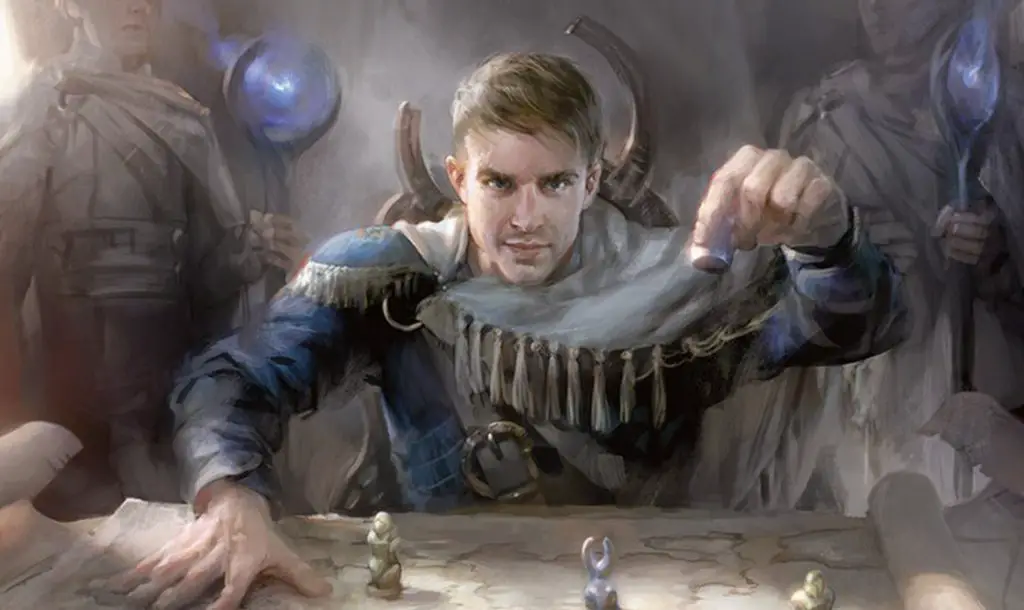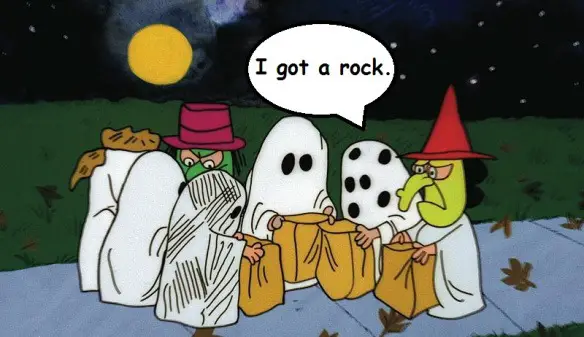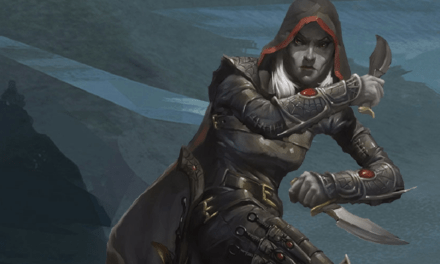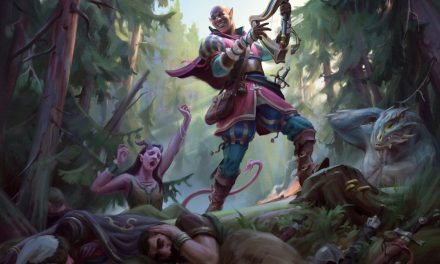While many Rogues in D&D 5e understand the value of a silent dagger or well-timed crossbow bolt, the Mastermind archetype focuses on a different approach.
Whether manipulating their enemies or even their allies, the Mastermind focuses on tactics.
Even in the most basic of conversations, there is always a certain game being played. These manipulative Rogues are keenly aware of that game and ensure that they will always be the one who wins in the end.
For those who seek to master these games, spoken or otherwise, this is the Mastermind Rogue Guide for D&D 5e.
What is the Mastermind Rogue in D&D 5e?
Operating as a manipulator who cleverly pulls the strings of any situation around them, the Mastermind understands people. Through their influence, these Rogues traffic in secrets, intrigue, and a frightening tactical prowess.
They particularly excel in social encounters where they are fully able to showcase their talents for manipulating others.
However, Masterminds are no slouch in combat either! They create openings in enemies’ defenses and are able to direct their allies to take full advantage of the situation.
The Mastermind archetype was introduced to D&D 5e in the Sword Coast Adventurer’s Guide and later republished in Xanathar’s Guide to Everything.
Role in the Party
A Mastermind will likely find themselves in the middle or back of the party’s formation. From there, they are able to attack with ranged weapons while keeping themselves safe and using their Master of Tactics ability to dangerous effect.
Outside of combat, the Mastermind can flourish as a Face for the party. This is especially true if the party finds itself dealing with unsavory characters or needs to find some creative approaches to social problems.
Because of this, the Mastermind is a little bit of a hodgepodge. They contribute to the party’s damage output, but they shine best as a type of Support class. This is due to their Master of Tactics ability, which is very much the backbone of this subclass.
We’ll cover Master of Tactics some more in a moment. However, if you haven’t checked out our other article on Party Composition and Character Roles, I would recommend you check that out too!

Mastermind Rogue Features 5e
The Mastermind’s features do a great job of showcasing the subclass’s knack for manipulation.
Disguises, forgery, and words are just as useful in the hands of a Mastermind as a blade or bow.
Recommended: Sneak Attack in D&D 5e
Master of Intrigue (Level 3)
Right out of the gate, the Mastermind Rogue gains a whopping 5 new proficiencies!
Not to cheapen the experience, you’ll also be able to flex your skills as an exceptionally gifted mimic!
You gain proficiency with the disguise kit, forgery kit, and one gaming set of your choice. You also learn two languages of your choice.
Additionally, you can unerringly mimic the speech patterns and accent of a creature that you hear speak for at least 1 minute, enabling you to pass yourself off as a native speaker of a particular land, provided that you know the language.
On one hand, there’s a lot here.
Unfortunately, however, getting value out of these abilities is highly dependent on what kind of game your group is playing.
Disguise Kits are probably the most useful of these proficiencies. With some creativity, there are endless possible uses for being able to pass yourself off as someone else.
Infiltrating an enemy encampment or an exclusive event can be made easy with a good disguise and some social know-how!
Pssst! I cover how to REALLY use Disguise Kits in this article here!
Forgery Kits and Gaming Sets are less useful. These might be interesting for things like forging a note that gets you out of trouble in a pinch or a high-stakes game of three dragon ante, but they aren’t likely to be very valuable in most campaigns.
Languages and the ability to mimic others are similarly interesting but unlikely to be terrifically useful. If you get opportunities to infiltrate other groups for a bit of espionage, these are great. Otherwise, they’re just flavor.
But fret not, dear Rogue!
Becoming a Mastermind grants you yet another Mastery at 3rd level and it’s seriously cool…
Master of Tactics (Level 3)
In addition to being a Master of Intrigue at level 3, the Mastermind also becomes a Master of Tactics.
This ability is the core feature of the Mastermind archetype.
You can use the Help action as a bonus action.
Additionally, when you use the Help action to aid an ally in attacking a creature, the target of that attack can be within 30 feet of you, rather than within 5 feet of you, if the target can see or hear you.
This is used to assist an ally in attacking an enemy creature. Just declare which creature you are helping your ally attack and your friend will have advantage when they roll their first attack against the creature!
The best part? The creature can be up to 30 feet away from you instead of having to be 5 feet away! As long as that enemy can see or hear you, you’re able to create that opening for your ally!
This is particularly vital when you’re trying to line up a big hit like a Paladin’s Divine Smite.
Master of Tactics will be competing with your Cunning Action for use as a bonus action though. However, you are less likely to need Cunning Action if you aren’t right up on your enemies.
Because of this, the Mastermind Rogue is typically best when given a ranged weapon so that they can use their bonus action to consistently give their allies advantage each round with Master of Tactics. Otherwise, they will need to be using that bonus action for Cunning Action while in the thick of it.
Keep in mind: the Mastermind works best when they’re creating openings for their allies. Unfortunately, you aren’t able to give yourself advantage with this ability.
Because of this, you will want to make sure that you are coordinating with your party members so that you have a playbook for your party’s tactics.

Insightful Manipulator (Level 9)
The Mastermind Rogue understands that there is always a subtext to any conversation. While those who aren’t skilled in the arts of manipulation may not notice these, they are nevertheless still at play.
That is where the Mastermind Rogue’s level 9 feature, Insightful Manipulator, comes into play.
If you spend at least 1 minute observing or interacting with another creature outside of combat, you can learn certain information about its capabilities compared to your own.
The DM tells you if the creature is your equal, superior, or inferior in regard to two of the following characteristics of your choice: Intelligence, Wisdom, Charisma, Class levels (if any).
At the DM’s option, you might also realize you know a piece of the creature’s history or one of its personality traits, if it has any.
In a campaign with lots of intrigue and roleplaying opportunity, this is a potentially very useful feature. You can possibly find new adventure hooks or better prepare for what’s to come based on the information that you gain from your observations.
If you’re playing more of a classic dungeon crawl, though, this ability is pretty useless. In these campaigns, anyone that you’re talking to for longer than a minute is unlikely to be someone that you need to size up.
It happens, but still…
Recommended: Complete Guide to the Rogue in D&D 5e
Misdirection (Level 13)
Remember that playbook we talked about when discussing the Master of Tactics ability? Yeah, you’re going to want to pull that back out!
Let’s get tactical!
When you are targeted by an attack while a creature within 5 feet of you is granting you cover against that attack, you can use your reaction to have the attack target that creature instead of you.
There’s a fair bit going on with this ability, so let’s break this down a bit.
The book states that you can cause another creature to suffer an attack that was meant for you. However, a few things need to be lined up for this to happen.
First, you must be targeted by the attack.
Something like a melee or spell attack (like Ray of Frost) would qualify. A spell like Lightning Bolt that affects multiple targets would not.
Secondly, a creature must be within 5 feet of you AND must be granting you cover.
Notice that the ability’s description says “a creature” and not “an ally”? We’ll touch back on that shortly.
Third, you then use your reaction to have the attack hit the creature that is providing you cover instead of yourself.
We’ve already covered the importance of Action Economy in another article. It’s definitely worth reading that as well to get ideas on how to use your reaction to the best effect!
So let’s now put all of this together…
Getting the Most Use Out of the Mastermind’s Misdirection Ability
The ideal situation to use this ability is when you have cover thanks to another enemy.
Let’s say that Hobgoblin A is right in front of you. The hobgoblin’s friend (affectionately named Hobgoblin B…) several feet back attempts to fire an arrow at you.
You have cover because of Hobgoblin A’s position. Now you can use your reaction to cause the arrow that Hobgoblin B fired to hit their ally instead of you as a result of your Misdirection.
That’s the “ideal” situation. However, it’s also not the most likely situation.
So things get a bit sticky now…
If it’s the difference between your character standing upright or being dropped to 0 hit points, your ally might not mind taking the hit for you. Otherwise, the attack that’s meant for you likely has just as much chance of hitting your front-line party member as it does you with your +2 AC bonus from the cover that they provide.
So, to get an enemy in front of you to even use this feature, you will need to be closer to the actual fight in combat. You want to bait them into getting close. Because of this, it’s easier to use this if you’re using melee weapons.
This means that the tactic of staying at range now becomes far less ideal. As I covered in my article explaining Ranged Combat, things get very difficult if enemies close in on you.
All in all, it gets awkward and feels like you’re generally having to choose between getting generally better use out of Master of Tactics OR Misdirection.
That said, pulling Misdirection off successfully is just pure, sweet value. Not only do you not get hit by the attack, but it damages another enemy creature instead.
If this is enough to down them, even better!

Soul of Deceit (Level 17)
At level 17, the Mastermind gets their capstone feature, Soul of Deceit.
This is it: the pinnacle, nay, the truest crème de la crème of the Mastermind Rogue’s features.
Your thoughts can’t be read by telepathy or other means unless you allow it.
You can prevent false thoughts by succeeding on a Charisma (Deception) check contested by the mind reader’s Wisdom (Insight) check.
Additionally, no matter what you say, magic that would determine if you are telling the truth indicates that you are being truthful if you so choose, and you can’t be compelled to tell the truth by magic.
Unfortunately, the crème is apparently expired, flat, and almost certainly poisonous.
I’ve been alternating between staring at my screen and my book for like an hour now trying to think of a way to frame this feature without sounding like the absolute grumpiest person on the Internet.
Of all the ruses that the Mastermind Rogue is capable of, getting our hopes up for this capstone feature is perhaps the most cruel.
On a surface level, this seems fun. But I really expect a lot from a feature that you get at such a late stage of the game. This is doubly true for a capstone feature!
But this?!
As far as features go, it’s like ordering steak and getting served liver.
Who is Soul Of Deceit Even For?!
Rant Time!
The primary method of reading minds in D&D 5e is the Detect Thoughts spell. It’s great and delivers a ton of value to the PCs who are using it. The PCs.
Most enemies aren’t trying to read your character’s thoughts. There might be some kind of intense situation where you’ve been captured and the enemy is trying to use Detect Thoughts and/or Zone of Truth on you, but, at level 17, that’s just unlikely.
And speaking of Zone of Truth…
Zone of Truth does not force you to tell the truth. It prevents you from lying.
This is an important distinction that must be made. While in a Zone of Truth, you can dodge the questions, do some fast-talking, or do anything other than knowingly lie.
If we’re taking the words of Zone of Truth and Soul of Deceit for exactly what they are, Soul of Deceit doesn’t even counter Zone of Truth. You can’t be compelled to tell the truth and you can’t lie, but everything in between is fair game.
So, Soul of Deceit gives you two abilities that are basically useless.
Sorry-not-sorry, but this is a dumpster-tier ability. I’d be less upset if it were acquired at a lower level, but while everyone else is enjoying their high-level features, the Mastermind gets… this garbage…
I can’t help but imagine the Mastermind Rogue as Charlie Brown during Halloween at this point…

Connections
Because the Mastermind Rogue is so woven into the intrigue of the story, they can be connected to the world in numerous ways. In fact, it’s possible that they are tied in in multiple ways that seemingly aren’t even related.
Such a character might have a number of backstories and identities depending on who is asking!
Do they work as a blackmailer in the elusive Thieves’ Guild? Perhaps this character serves a noble who isn’t above using the espionage that defines the Mastermind’s craft.
To go a different route, they might assist the city guards as a type of counterspy, undercover agent, or security expert.
A Mastermind Rogue deep undercover in a shady organization could be a very interesting character. I picture something like D&D meets Reservoir Dogs.
(Which, if that sounds interesting, you will definitely want to check out my article about Quentin Tarantino as a DM!)
Whatever capacity the Mastermind Rogue is brought into the story with, it’s almost certainly part of a grander scheme. After all, these characters have ulterior motives for their ulterior motives!
Is the Mastermind Rogue Good?
Honestly? Meh.
In certain groups playing certain types of games, the Mastermind Rogue can be an incredibly cool class.
There is so much flavor to work with here and Master of Tactics is a crazy useful ability in combat.
However, most of this class’s features are certainly geared towards a game that is very heavy on the RP side. It may work for your group, but it likely won’t work for most.
While the Mastermind is scouring the city, mingling with the who’s-who, and gathering information, you have 4+ other players who are now checking their phones and getting bored.
Trying to include situations for the Mastermind Rogue to show off their abilities in a campaign that isn’t already primarily about roleplaying can hurt the game as a whole.
However, without doing that, the Mastermind only really has two unique abilities to use in combat. Assuming that the game has gone from level 2 to level 17, the novelty of Master of Tactics would almost certainly wear thin by level 10.
A good subclass should complement and enhance the base features of its class, but I feel that Mastermind just misses this mark. If I’m wanting to play a manipulative spy-type character, there’s no real compelling reason to choose the Mastermind over the College of Whispers Bard.
Where the Mastermind does shine, however, is as a villain. This is someone who could somehow be inexplicably one step ahead of the party at all times.
Even if they aren’t an outright villain, they could be a mysterious agent who sometimes works against the party.
With their own abilities and informants, the Mastermind has all the makings of a great foil for the party baked right in!
Related: Ranking Every Rogue Subclass in D&D 5e
Conclusion – Mastermind Rogue in D&D 5e
So that wraps it up for the Mastermind Rogue Guide for D&D 5e.
I know I was pretty rough on this class there at the end, but I really do hold high-level features up to a high standard. It hit a point that I was wondering if there was something that I’m missing!
Because I have a deep love for running games steeped in RP and intrigue, I would love to have a Mastermind Rogue in my group if that’s the type of game that we’re playing. I could easily see it adding some wonderful suspense to the table.
But that’s still going to take a lot of finesse to work in just right in a way that’s fun for EVERYONE at the table.
What are your thoughts on the Mastermind Rogue? Was I too rough on our favorite schemer?
Let me know in the comments and don’t forget to sign up for the Tabletop Joab newsletter below so you can be the first to check out all of our new content!









